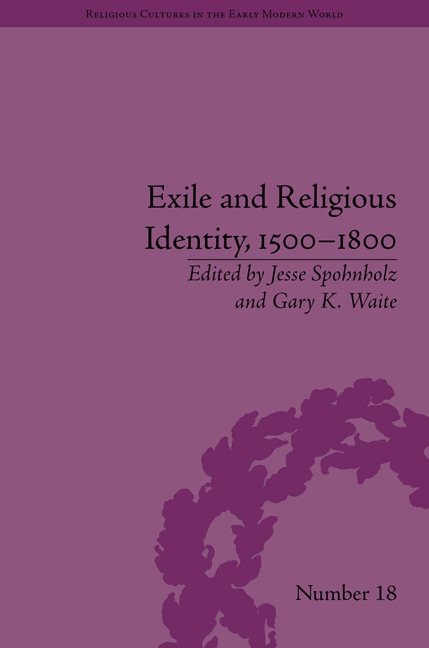Book contents
- Frontmatter
- CONTENTS
- Acknowledgements
- List of Contributors
- List of Figures and Tables
- Introduction
- Part I The Experience of Exile and the Consolidation of Religious Identities
- Part II The Experience of Exile and the Destabilization of Religious Identities
- 5 Dirck Volckertz Coornhert: Exile and Religious Coexistence
- 6 Isaac Nabrusch, Christian and Jew: A Pious Man at Life's Many Crossroads
- 7 Justus Velsius Haganus: An Erudite but Rambling Prophet
- 8 Instability and Insecurity: Dutch Women Refugees in Germany and England, 1550–1600
- 9 Heresy and Commercial Exchanges in Early Modern Northern Spain
- Part III The Memory of Exile
- Notes
- Index
7 - Justus Velsius Haganus: An Erudite but Rambling Prophet
from Part II - The Experience of Exile and the Destabilization of Religious Identities
- Frontmatter
- CONTENTS
- Acknowledgements
- List of Contributors
- List of Figures and Tables
- Introduction
- Part I The Experience of Exile and the Consolidation of Religious Identities
- Part II The Experience of Exile and the Destabilization of Religious Identities
- 5 Dirck Volckertz Coornhert: Exile and Religious Coexistence
- 6 Isaac Nabrusch, Christian and Jew: A Pious Man at Life's Many Crossroads
- 7 Justus Velsius Haganus: An Erudite but Rambling Prophet
- 8 Instability and Insecurity: Dutch Women Refugees in Germany and England, 1550–1600
- 9 Heresy and Commercial Exchanges in Early Modern Northern Spain
- Part III The Memory of Exile
- Notes
- Index
Summary
Only a few people have left so many traces in the sources, yet were so utterly unsuccessful in achieving what they saw as their ultimate destiny, as Justus Velsius Haganus (c. 1510–after 1581). This Dutch scholar did indeed make a deep impression on many of his contemporaries, and his name figures in many studies of the Reformation. The oldest of the extensive biographical studies, published in 1885 by the Mennonite church historian Christiaan Sepp, is still the richest. In 1957 Elisabeth Feist-Hirsch authored another very useful biographical sketch. Except where otherwise specified, this contribution relies on these two studies. In 1977 the French Dominican friar Jacques Vincent Pollet published a comprehensive collection of relevant sources.
The Jesuit demonologist Martin Delrio deemed Velsius a false prophet. John Calvin, in a 1556 letter to Philip Melanchthon, diagnosed Velsius as insane. Calvin's successor Theodore Beza unequivocally agreed with this assessment thirteen years later. In 1561 Heinrich Bullinger even went so far as to call Velsius ‘an enemy of Christ’. But, as we will see, these Reformed frontrunners did indeed have a bone or two to pick with Velsius. Not all of Velsius's contemporary critics were so negative. In 1556, when Velsius was still alive, his first biographer, the Basel professor Heinrich Pantaleon, listed him as one of Germany's heroes and illustrious men.
- Type
- Chapter
- Information
- Exile and Religious Identity, 1500–1800 , pp. 97 - 110Publisher: Pickering & ChattoFirst published in: 2014

